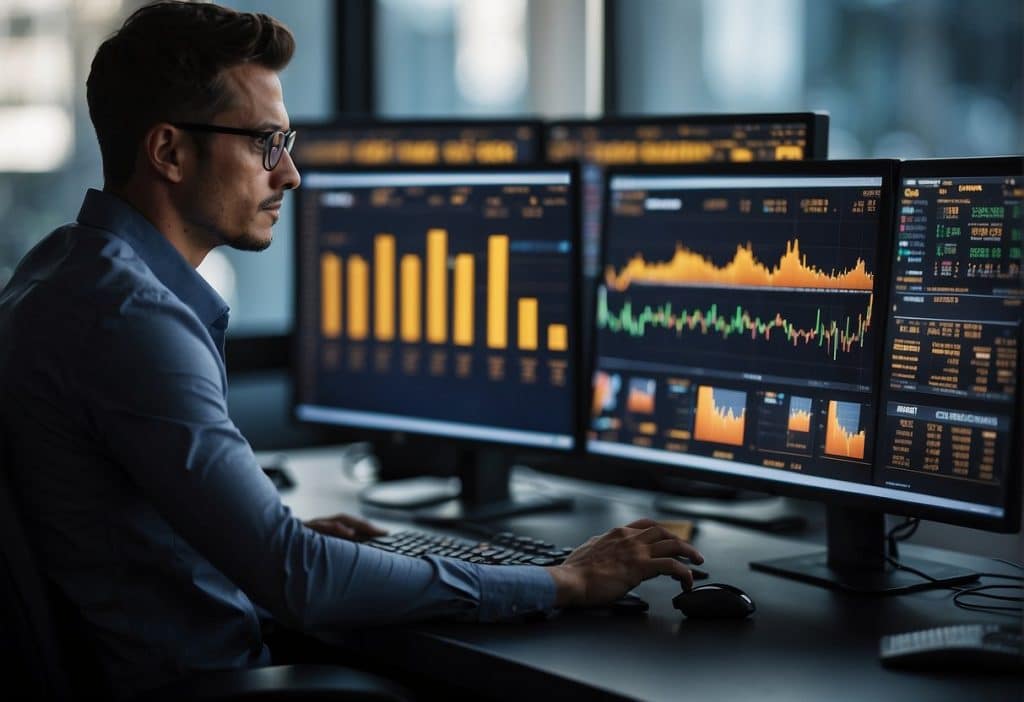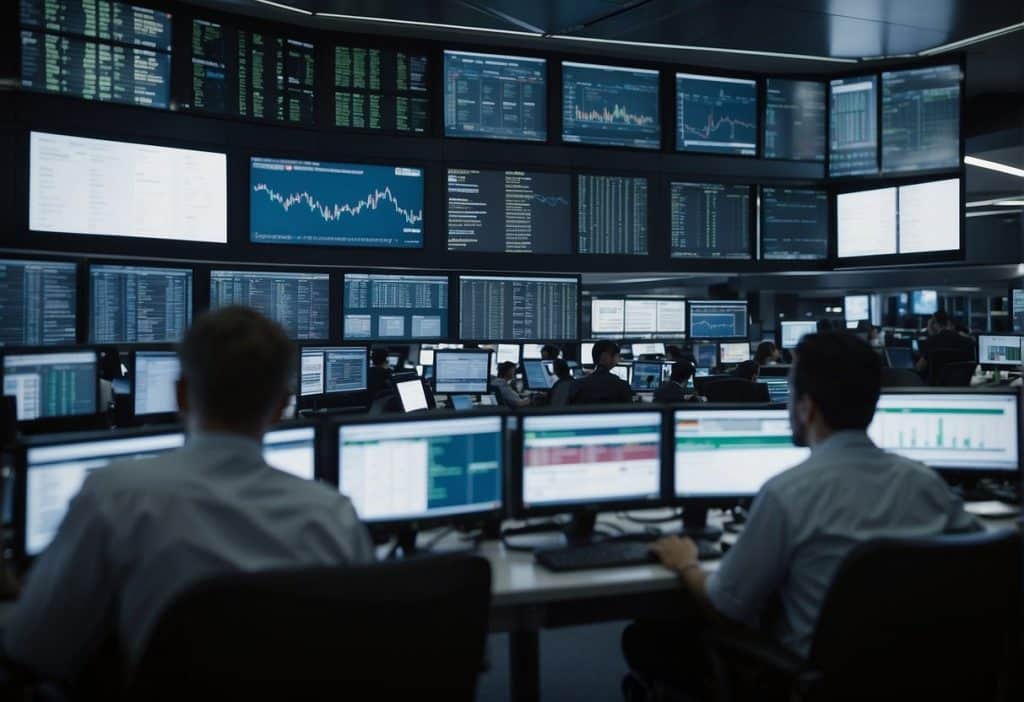Binance Futures is a prominent platform provided by Binance, the world’s largest cryptocurrency exchange by trading volume. It offers users the ability to trade futures contracts on various cryptocurrencies. With futures trading, you can speculate on the future price of cryptocurrencies, offering the possibility for profit even in volatile market conditions. You don’t purchase the actual asset; instead, you trade contracts based on the asset’s predicted future price.

Just as traditional futures, crypto futures allow investors to hedge against market risk and find opportunities to gain from market fluctuations. With Binance Futures, you can access a diverse range of contracts, including perpetual and quarterly contracts, which are denominated in either USDT or other digital assets. The platform is known for its low fees, tight spreads, and it supports a high leverage of up to 125x, providing you with the potential to multiply your gains.
Key Takeaways
- Binance Futures offers a platform for trading a variety of cryptocurrency futures contracts.
- Futures trading allows for speculation on the future price of cryptocurrencies without owning the actual assets.
- Binance Futures provides features like low fees, tight spreads, and high leverage options.
NOT YET A BINANCE USER?
Join today with the Binance Referral Code for exclusive benefits or read our Binance Review to learn why Binance is the right exchange for you!
GET UP TO 50% OFF TRADING FEES WITH THE CODE “WUPBLUYN”
Understanding Futures
In this section, you’ll learn about the fundamentals of futures contracts, how they differ from the spot market, and the different types of contracts available.
Basics of Futures Contracts
Futures contracts are agreements to buy or sell an asset at a predetermined price on a specified future date. Unlike the spot market where transactions occur immediately, futures contracts allow you to hedge against price changes and speculate on the future value of assets. Perpetual futures, unlike traditional futures, do not have an expiry date and are often used in the cryptocurrency markets.
Futures vs. Spot Market
The key difference between the futures and the spot market is the timing of the asset exchange. In the spot market, the exchange of assets occurs on the spot, or almost immediately, while a futures contract binds you to a transaction at a future date. Factors like liquidity and volatility can vary greatly between the two markets. The futures market often provides higher liquidity and can accommodate large trades with minimal impact on the price of the asset.
Types of Futures Contracts
Futures contracts can be classified into two main types:
- Standard Futures: Have a set expiry date, often on a quarterly basis.
- Perpetual Futures: Do not expire and mimic a spot market position with the addition of a funding fee.
For example, Bitcoin futures are derivative products that derive their value from the underlying cryptocurrency, Bitcoin. Quarterly contracts settle on a predetermined date each quarter, whereas perpetual futures can be held indefinitely, mimicking a standard spot market position but with the leverage and market exposure that futures contracts provide. Coin-M futures are settled in the underlying cryptocurrency instead of fiat currency or stablecoin.
Binance Futures Trading Platform
The Binance Futures Trading Platform enables you to engage in futures contracts with cryptocurrencies, utilizing advanced tools to manage your trades and risks effectively. The platform offers a robust trading interface designed for a seamless user experience.
Creating a Binance Account
To start trading on Binance Futures, the initial step is to create a Binance account. Sign up on the Binance website by providing your email address and creating a password. Once registered, you must complete the Know Your Customer (KYC) process, which involves verifying your identity to enhance account security and comply with regulatory standards. After successful KYC verification, access the Binance Futures trading platform by navigating to it through the main Binance interface.
- Step 1: Visit Binance’s website and click on “Register”.
- Step 2: Provide the necessary personal details.
- Step 3: Verify your email and complete your profile set-up.
- Step 4: Complete the KYC verification.
- Step 5: Access the Binance Futures trading platform.
Binance Futures Interface
Once you’ve accessed the Binance Futures platform, you’ll find a trading interface that is both comprehensive and customizable to fit individual trading needs. Key elements of the trading interface include:
- Market overview: Real-time price movement displayed through charts.
- Order book: Details of current bids and asks.
For making trades, Binance Futures offers margin modes including cross margin and isolated margin, which determine how your available balance is used and risks are managed. The trading interface also includes pertinent details like the Simple Moving Average (SMA) among other technical analysis tools to inform your trades.
- Market Analysis Tools:
- Chart: A detailed graphical representation of price action.
- Indicators: Including SMA to analyze market trends.
- Margin Information:
- Cross Margin Mode: Risks and profits are shared across all open positions.
- Isolated Margin Mode: Risks are managed separately for individual positions.
- Order Placement Panel:
- Buy/Sell Options: Set market, limit, stop-limit, and other order types.
- Leverage Slider: Adjust your desired leverage level up to a certain limit.
The platform’s interface strives to balance sophistication with usability, ensuring that both novice and experienced traders can navigate and utilize the features effectively.
Trading Strategies and Techniques

In futures trading on platforms like Binance, employing the right strategies is crucial to navigate the market effectively. You’ll learn how to utilize leverage and margin trading, understand risk management, and the use of trading bots for automation to potentially improve your trading outcomes.
Leverage and Margin Trading
When you engage in leverage trading on Binance Futures, you’re essentially borrowing funds to increase your trading position beyond what would be available from your cash balance alone. It’s vital to understand the two types of margin modes: isolated margin and cross margin. Isolated margin allows you to manage risk by limiting it to an individual trade, while cross margin risks your entire margin balance across all positions. Collateral is what you use as security for these leveraged positions.
- Leverage: Amplifies your trading power.
- Margin: The collateral you contribute.
- Liquidation: If the market moves against you significantly, your position may be liquidated, leading to a loss of your margin.
Here’s a quick look at key considerations:
| Factor | Isolated Margin | Cross Margin |
|---|---|---|
| Risk | Confined to a single position | Shared across all open positions |
| Flexibility | Control over each trade’s exposure | Less control, global account risk |
Risk Management in Futures Trading
Effective risk management is the cornerstone of successful futures trading. Integrate stop-loss orders to limit potential losses and preserve capital. Keeping an eye on the funding rate can also help you understand market sentiment and potential costs or profits from holding positions over an extended time. Utilize calculated position sizing to prevent substantial losses, especially with leveraged trades where the risk of liquidation is higher.
Risk Management Tools:
- Stop-Loss Order: Automatically closes a position at a predetermined price.
- Position Sizing: Determines how much capital can be risked on a trade.
Use of Trading Bots and Automation
Trading bots harness the power of automation to implement strategies like Grid Trading, which places buy and sell orders within a predefined price range. These tools operate using technical indicators like the Simple Moving Average (SMA) to inform decisions. Bots can execute trades faster than manual trading, potentially capturing profitable opportunities or minimizing losses.
Automation Benefits:
- Operate 24/7 without manual input.
- Remove emotional decision-making.
- Apply complex strategies with precision.
When incorporating these tools and techniques into your Binance Futures trading, always ensure you’re informed about the assets and the strategies you’re using. Understanding these fundamentals gives you a more robust trading foundation.
Key Market Indicators and Tools

In the dynamic world of Binance Futures, your trading strategy hinges on a strong understanding of market indicators and analysis tools. These elements are critical in making informed decisions and can significantly impact your trading outcomes.
Understanding Liquidity and Volume
Liquidity refers to the ease with which an asset can be bought or sold in the market without affecting its price. High liquidity is often synonymous with a less volatile market where large orders can be executed with minimal slippage. Trading Volume, on the other hand, indicates the number of units of a cryptocurrency that have been traded within a set period and is a key metric of market activity and sentiment.
- Liquidity:
- Crucial for executing large orders.
- Minimizes slippage.
- Trading Volume:
- Reflects market activity.
- Can signal trend strength.
Technical Indicators and Charts
Technical indicators are algorithmic calculations based on the price, volume, and/or open interest of a security or contract. They are used by traders to forecast future market movements. Two commonly utilized technical indicators in Binance Futures are the Simple Moving Average (SMA) and the Exponential Moving Average (EMA), which help in smoothing out price fluctuations to identify trends.
- Simple Moving Average (SMA):
- Calculates the average asset price over a specific period.
- Helps identify overall price trends.
- Exponential Moving Average (EMA):
- Gives more weight to recent prices and reacts more quickly to price changes than SMA.
- Useful for identifying short-term trend directions and potential reversals.
Price Charts are invaluable tools that provide a visual representation of market data, often displaying the historical and current prices of an asset. They lay the foundation for utilizing technical indicators and understanding market movements. Volatility, which is inherent in the cryptocurrency markets, can be more easily examined and understood through the use of detailed price charts.
- Price Charts:
- Visualize market data.
- Are the basis for applying technical indicators like SMA and EMA.
Frequently Asked Questions
Understanding the intricacies of Binance Futures can optimize your trading experience. This section answers key questions to enhance your familiarity with the platform’s features and risks.
How to trade on Binance Futures?
To trade on Binance Futures, you must first create an account on the Binance platform. Once your account is set up and funded, you can navigate to the Futures section, choose the contract you wish to trade in, and place your order (buy/sell) with the desired price and quantity.
What are the fees associated with Binance Futures trading?
Binance Futures charges a trading fee for each transaction, consisting of a maker fee and a taker fee. The fees vary based on your level in the Binance VIP program, which is determined by your trading volume and BNB balance.
Can you explain the use of the Futures Calculator on Binance?
The Futures Calculator on Binance helps you estimate potential profits or losses, liquidation prices, and required margin. It allows you to plan your trades based on various inputs like entry price, exit price, leverage, and position size.
What steps should a beginner take to start trading on Binance Futures?
As a beginner, start by thoroughly researching how futures trading works. Next, try the Binance Futures testnet to practice without real funds. Once comfortable, complete your KYC on Binance, deposit funds, and gradually begin trading with small positions to manage risk effectively.
What are the risks involved in Binance Futures trading?
Trading Binance Futures carries risks like significant financial losses due to market volatility and the use of leverage, which can amplify both gains and losses. Always trade within your risk tolerance and avoid investing more than you can afford to lose.
How do leverage and margin work in Binance Futures?
Leverage in Binance Futures allows you to open larger positions with a smaller amount of capital. Margin is the collateral you put up to maintain your leveraged position. Higher leverage can lead to higher returns but also increases potential losses and the risk of liquidation.
